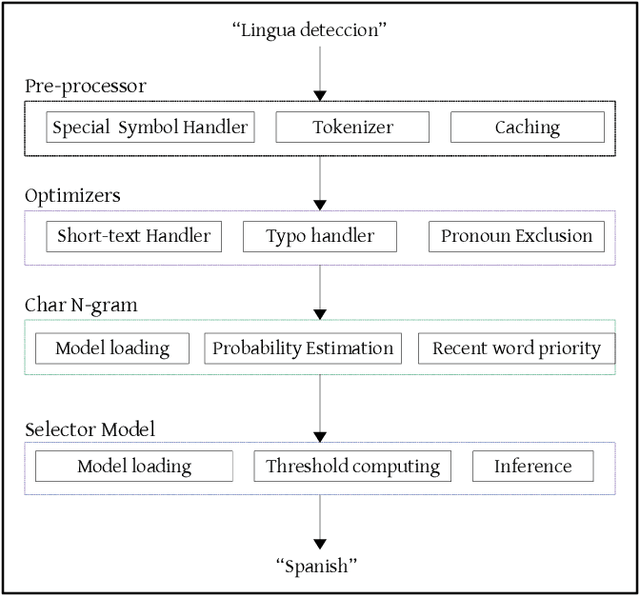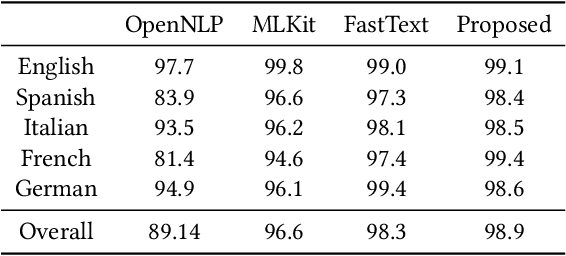Ankur Agarwal
Language Detection Engine for Multilingual Texting on Mobile Devices
Jan 07, 2021



Abstract:More than 2 billion mobile users worldwide type in multiple languages in the soft keyboard. On a monolingual keyboard, 38% of falsely auto-corrected words are valid in another language. This can be easily avoided by detecting the language of typed words and then validating it in its respective language. Language detection is a well-known problem in natural language processing. In this paper, we present a fast, light-weight and accurate Language Detection Engine (LDE) for multilingual typing that dynamically adapts to user intended language in real-time. We propose a novel approach where the fusion of character N-gram model and logistic regression based selector model is used to identify the language. Additionally, we present a unique method of reducing the inference time significantly by parameter reduction technique. We also discuss various optimizations fabricated across LDE to resolve ambiguity in input text among the languages with the same character pattern. Our method demonstrates an average accuracy of 94.5% for Indian languages in Latin script and that of 98% for European languages on the code-switched data. This model outperforms fastText by 60.39% and ML-Kit by 23.67% in F1 score for European languages. LDE is faster on mobile device with an average inference time of 25.91 microseconds.
* 2020 IEEE 14th International Conference on Semantic Computing (ICSC). Accessible at https://ieeexplore.ieee.org/document/9031474
On- Device Information Extraction from Screenshots in form of tags
Jan 11, 2020



Abstract:We propose a method to make mobile screenshots easily searchable. In this paper, we present the workflow in which we: 1) preprocessed a collection of screenshots, 2) identified script presentin image, 3) extracted unstructured text from images, 4) identifiedlanguage of the extracted text, 5) extracted keywords from the text, 6) identified tags based on image features, 7) expanded tag set by identifying related keywords, 8) inserted image tags with relevant images after ranking and indexed them to make it searchable on device. We made the pipeline which supports multiple languages and executed it on-device, which addressed privacy concerns. We developed novel architectures for components in the pipeline, optimized performance and memory for on-device computation. We observed from experimentation that the solution developed can reduce overall user effort and improve end user experience while searching, whose results are published.
Predicting Response-Function Results of Electrical/Mechanical Systems Through Artificial Neural Network
Jun 24, 2003


Abstract:In the present paper a newer application of Artificial Neural Network (ANN) has been developed i.e., predicting response-function results of electrical-mechanical system through ANN. This method is specially useful to complex systems for which it is not possible to find the response-function because of complexity of the system. The proposed approach suggests that how even without knowing the response-function, the response-function results can be predicted with the use of ANN to the system. The steps used are: (i) Depending on the system, the ANN-architecture and the input & output parameters are decided, (ii) Training & test data are generated from simplified circuits and through tactic-superposition of it for complex circuits, (iii) Training the ANN with training data through many cycles and (iv) Test-data are used for predicting the response-function results. It is found that the proposed novel method for response prediction works satisfactorily. Thus this method could be used specially for complex systems where other methods are unable to tackle it. In this paper the application of ANN is particularly demonstrated to electrical-circuit system but can be applied to other systems too.
 Add to Chrome
Add to Chrome Add to Firefox
Add to Firefox Add to Edge
Add to Edge